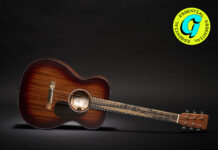
20 best overdrive pedals to buy in 2019
Most guitarists would agree that an overdrive pedal is an essential part of any ’board, and for good reason. Whether you’re a metalhead looking to push the front-end of a high-gain amp, a blues player who wants to add sizzle to their solos or a jazz guitarist after a slight boost, overdrive stompboxes will fit the bill.
So, in no particular order, here are our picks of the 20 best overdrive pedals you can buy in 2019.
Hudson Electronics Broadcast
Hand-built on stripboard using top-of-the-line components in Hudson Electronics’ Yorkshire workshop, the Broadcast might look like it’s come straight out of a 1960s recording studio, but the ideas displayed within are innovative and original.
Effectively a preamp based on the classic Neve recording consoles of the 1960s, the Broadcast can behave as both a tone-enhancing clean boost or a raucous overdrive pedal, depending on whether you choose the high- or low-gain option. At its most extreme, it’ll even sound a bit like an old fuzzbox, but without ever losing its refined sonic enhancement and superb touch dynamics.
Retails for $285/£155. Read our full review here.
Analog Man King Of Tone
The King Of Tone’s reputation is as much about its scarcity as it is the undeniable quality of the pedal itself. If you want one of Mike Piera’s creations, you’d better not be in a rush. The waiting list is approaching two years, and if you can find one second-hand, expect to pay at least double the price of a new one.
Why all the fuss? Well, the likes of Brad Whitford and Jimmy Herring have long prized the King Of Tone for its clear, uncoloured overdrive that enhances, rather than masks, the tone of your signal chain. The difference between the KoT and that other mythical transparent overdrive, the Klon Centaur, is you can still buy one, though that might not be the case for long. Piera admits once his stock of required diodes and capacitors are exhausted, he won’t be able to make any more.
Retails from $265. Read our interview with Mike Piera here.
EarthQuaker Devices Westwood
It takes a lot to really stand out in the world of overdrive pedals, but the EarthQuaker Devices Westwood certainly has done so since its launch last year.
Taking the Tube Screamer as its basis, the Westwood sets itself apart from other green overdrive pedals, offering a wonderfully flattering and subtle natural overdrive sound that compresses like you’d want thanks to its superbly effective tonestack, but without colouring the EQ in any discernible way.
There are plenty of ‘transparent overdrives’ out there, but the Westwood is designed to be ‘translucent’ – and with its sweet, smooth and responsive sound, it’s one of the finest drive pedals on the market today.
Retails for $179/£185. Read our full review here.
Fulltone OCD V2
Michael Fuller debuted the Obsessive Compulsive Drive all the way back in 1994. It’s gone on to become one of the biggest-selling boutique overdrives on the planet, and a go-to for professional players of every stripe.
Its party trick is to essentially recreate the sound and (importantly) the feel and response of a cranked amplifier in a pedal. The OCD has a large dynamic range and offers a continuum of usable sounds – from clean boost to gritty, harmonic-laden fuzzy distortion. The clarity of the OCD has seen players as varied as Robin Trower, Keith Urban, Joey Santiago and Paul Gilbert attracted to its addictive charm and crunch. We’re pretty sure you will be, too.
Retails for $159/£139. More info here.
J Rockett Audio Designs Archer Ikon
For sensible money, the Archer Ikon is about the closest you’re going to get to the hallowed sounds of the Klon Centaur, discontinued in 2009. That’s partly because it was created by Chris Van Tassel and Jay Rockett, who worked with Bill Finnegan on his Klon KTR – the follow-up to the Centaur.
As a result, it has a wonderful clean boost that adds a stellar high-end sheen, and there’s also plenty of grit on tap if you want it. It’s not cheap, but the Archer Ikon offers 95 per cent of the Klon experience for 10 per cent of the price.
Retails for $199/£165. Read our full review here.
RYRA The Klone
The Klone is the brainchild of Texan solo builder Shane Logan (aka Rock Your Repaired Amp), and as its rather transparent name suggests, its intent is to replicate the famous Klon Centaur overdrive pedal. The Klone gets closer than pretty much all other replications, however, perhaps because it’s painstakingly crafted using identical components to the legendary original. For an overdrive pedal, it’s not cheap, but it’s a hell of a lot cheaper than the sum a real Klon commands these days.
Retails for $190/£195. More info here.
JHS Pedals Morning Glory V4
The Morning Glory is JHS Pedals’ most popular pedal, and the one that made Josh Scott’s name as a boutique builder to watch when it was created all the way back in 2009.
It’s since won Scott a bucketload of awards on the back of its wonderfully transparent quality, which adds everything you’d want to your amp’s sound – sweet overdrive, improved tonal nuance and responsiveness – while retaining the fundamental character of the amp that made you buy it in the first place.
The current fourth edition also adds a gain-boost toggle to ramp up your solos and lead parts, which can be independently switched with the addition of JHS’ Red Remote.
Retails for $199/£195. More info here.
Boss JB-2 Angry Driver
Boss has been making compact effects pedals for 40 years now, and while the company’s iconic stompboxes continue to be a staple of ’boards the world over, the rise of the boutique builder has made the compact pedal seem a little bland by comparison.
In 2018, however, the Japanese giant decided to capture a bit of boutique kudos itself by teaming up with Josh Scott of JHS Pedals to create the Angry Driver. Effectively a hybrid of Scott’s Angry Charlie and the iconic Boss Blues Driver, the JB-2 is a dual-mode drive pedal that offers a huge palette of overdrive sounds thanks to independent tone-shaping controls for both voices, and the ability to run them independently, in series or parallel.
Retails for $199.99/ £149. More info here.
Keeley D&M Drive
Created with the input of That Pedal Show hosts Mick Taylor and Daniel Steinhardt, the D&M Drive is a twin-voiced overdrive and boost that offers remarkable tonal versatility in a relatively compact two-switch pedal.
The boost side of things offers everything from a rich, midrange bluesy boost all the way to a dynamic overdrive with wonderful touch sensitivity, while the drive side of the equation runs the gamut from valve-like overdrive to searing rock leads. With the ability to alter their signal order as you run them together, the D&M Drive could replace two or even three pedals on your board.
Retails for $/£229. More info here.
Ibanez TS80840TH
We’d be remiss not to include this here. The Ibanez TS808 Tube Screamer has earned itself a congregation of devotees since its debut in 1958, and six decades later, not much has changed. Ibanez’s 40th-anniversary reissue of the icon isn’t a little green box but a sparkling ruby one – but within its chassis, you’ll find the same all-analogue circuitry and JRC4558D IC chip.
Designed to mimic the growl of overdriven tubes, the TS808 offers a compressed, sweet and full overdrive that rockers and bluesmen haven’t been able to do without. The stompbox, although mid-boosted, doesn’t colour the original tone of your guitar too much, allowing it – and your playing – to shine.
The TS808’s three knobs – overdrive, tone and level – make it as beginner-friendly as it is essential. Keep your guitar as the main star of the show with the OD on low, or give your licks and solos a boost by cranking up the volume.
Part of the Tube Screamer’s beauty lies in pairing it with other gain pedals, or letting it drive the front-end of your amp. You’ll find that it elevates the performance of your other stompboxes, which is perhaps one good reason why every single guitarist has bought, borrowed or stolen a Tube Screamer-style pedal in their playing lifetimes.
Retails for $/£199. More info here.
ThorpyFX Gunshot
The Gunshot is great for everything from throaty 70s-style overdrive to creamy lead tones to aggressive riff-rock, evoking the punch, responsiveness and harmonic content you’d typically associate with a high-end tube amp. It sounds best in medium- to high-gain settings, so look elsewhere if you’re after a clean boost.
The key to unlocking this pedal’s potential comes from balancing two discrete, yet stacked, gain stages with the calibre cascading into the gain control. Winding up the gain introduces a Tube Screamer-like mid-hump, while the calibre possesses more pronounced lows and highs, so the best results are yielded by balancing both to suit the voicing of your guitar and amp.
Retails for £139.99. Read our full review here.
Boss SD-1 Super OverDrive
Like the DS-1, the Boss SD-1 is a classic pedal used by countless guitarists both professional and amateur. The overdrive pedal is favoured not necessarily for its tone but its affordability, indestructibility, simplicity and availability.
The petite yellow stompbox has plenty to offer for guitarists of all genres. Used alone, it offers that subtle tube warmth that blues, classic rock and jazz players will dig. But use it to boost an angrier distortion box (or a cranked-up amp), and even metalheads will find a home for it on their ’boards.
Its trio of knobs are identical to the TS808’s, letting you tweak only the gain, output level and tone. The SD-1 is a proudly unfancy workhorse seemingly designed for one purpose: to do a good job more cheaply than anyone else.
Retails for $49.99/£43.45. More info here.
Chase Bliss Audio Brothers Analog Gainstage
It’s a boost, it’s an overdrive, it’s a fuzz. The Chase Bliss Audio Brothers does it all – and exponentially more, thanks to the unique design of this slim stompbox. If you love experimenting with your gear to coax off-kilter sounds from your guitar, the Brothers offers a complex and interactive puzzle to solve.
The pedal warrants its steep price tag for the sheer amount of thought and technical expertise that Chase Bliss Audio put into it. The Brothers has two significantly distinct channels, each with three modes, that you can route in series or parallel to unlock dozens of tones. The downside? It isn’t exactly the most straightforward pedal to use.
One channel is based on a JFET-based drive circuit, while the other uses a series of integrated circuits. Each has boost, overdrive and fuzz modes, selectable via a three-way mini toggle. You can cascade the channels either way or blend them in parallel with a mix knob right in the middle of the enclosure. Thankfully, you’ll only have gain and tone knobs per channel – and a master volume dial – to contend with.
The OD on Channel A emphasises transparency while giving your tone a bit of a kick in the midrange. It’s a meaty, asymmetrically clipped and harmonics-rich overdrive that’s better for the raucous side of blues. Responsive and nuanced too, the drive at low-gain settings sounds just as musical. Channel B’s overdrive, on the other hand, is the more aggressive sibling: modern, highs-heavy and able to scythe through the mix.
You can then stack ’em together. This is the real triumph of the Brothers, as you can use one side to boost a drive on the other channel, or smash two fuzzes together. The collisions and clashes you’ll encounter will keep you twisting knobs for hours on end – and for those who welcome that challenge, Brothers is a beauty.
Retails for $/£349. More info here.
Paul Cochrane Timmy
This slim stompbox has been hyped up by countless guitarists since its introduction in the early noughties. And it’s for one quality above all that earned the Timmy its glowing reputation: transparency.
The overdrive pedal is revered for preserving the tone of your amplifier. It can be deployed as a clean boost to push your amp, an edge-of-breakup OD or a singing overdrive with a good dose of sustain, responsiveness and harmonics. You have four straightforward knobs – gain, volume, bass and treble – as well as a three-way voicing switch to dial in your tone. The switch toggles between two symmetrical clipping modes and an asymmetrical one.
There are numerous versions of the Timmy around, but for its 15th anniversary, Paul Cochrane unveiled a new edition with a few tweaks. These include reduced overdrive from the gain pot, a switch for gain boost and a 1458 op-amp. The builder claims the 1458 sounds less harsh on the trebles and less saturated.
Retails for $129.
King Tone The Duellist
The Duellist combines two markedly different overdrive circuits: on one side, the String-Slinger is a refined take on the Tube Screamer, and on the other, the Heavy-Handed is inspired by a 90s Marshall Bluesbreaker pedal.
The former is rich, thick and oozes classy harmonic content, with loads of responsiveness. The tone knob has a sensibly voiced range: instant closed-back heft or Blackface glassiness awaits at the flick of the three-way pre-clipping EQ switch.
The Heavy-Handed circuit adds a far superior range of volume, tonal control and gain to the Marshall unit it’s based on. It has more neutral EQ-curve than the String-Singer and an arguably more versatile voice that can take you from Clapton’s Blues Breakers days to Kossoff to Young. Stack both together and you’ll be rewarded with a soaring solo tone.
Retails for $349.99. Read our full review here.
Strymon Sunset
Like most Strymon products, the Sunset is a versatile and deeply configurable device. There are six overdrive circuits crammed into the red box, two of which can be engaged simultaneously and routed any way you want. You can stack both channels in series (either direction), run them in parallel or activate one at a time.
The circuits include the usual suspects alongside quirkier offerings. There’s a treble boost, a JFET-based clean boost and a smooth, mid-humped overdrive, as well as a two-stage OD that sends a soft-clipping stage into a hard-clipping one. All these options don’t make the Sunset a difficult beast to tame. Each channel only has three controls – level, tone and drive – and a three-position switch to add or reduce brightness to the global mix.
Retails for $/£349.99. More info here.
Walrus Audio Warhorn
Despite its Viking-inspired name and artwork, the Walrus Audio Warhorn isn’t a ferocious distortion pedal calling for Valhalla. It’s a transparent overdrive whose simplicity, usability and no-nonsense tone are highlights.
The Warhorn can go from a meaty, Tube Screamer-esque pedal to a cleaner, lusher and more ‘open’ overdrive at the flick of the two-way toggle switch in the middle of the stompbox. It’s a dramatic change in voicing, too, which Walrus attributes to a symmetrical, more compressed clipping in one setting and an asymmetrical, less compressed clipping in the other. Otherwise, you’ve your usual level, drive, bass and treble controls.
Retails for $199/£177. More info here.
Smallsound/Bigsound Fuck Overdrive
The pedal’s tongue-in-cheek name says it all. A product of Cymbals Eat Guitars’ Brian Hamilton distaste for the countless ‘transparent’ OD boxes on the market, Fuck Overdrive is beautifully cacophonous and hell-bent on producing the nastiest ‘blown-amp’ tones without actually obliterating your speakers.
Designed for guitarists who prefer the fringes of contemporary music, Fuck Overdrive is inspired by a series of records that’s hardly mentioned within guitar circles: William Basinski’s seminal The Disintegration Loops, a run of four albums that were built from crumbling, decades-old magnetic tapes that the experimental musician had attempted to salvage. As Basinski transferred the tapes to a digital medium, their physical form fell apart, resulting in the crackles, hisses, pops and ghostly whispers on the final cut.
This stompbox aims to recreate those sounds. It has two sections: a JFET-based overdrive, as well as the aptly titled “Boom”. The OD portion runs the gamut from warm, clean-ish boost to woolly fuzz. And, with the Boom activated, the pedal can go from hellish, gated sputters to subtle speaker crackles to compressed note blooms – depending on where you set the threshold dial and the Light/Heavy toggle switch. You can choose to set the Boom permanently on/off, or activate/deactivate it momentarily with a footswitch.
Part of the fun is hearing how the Fuck Overdrive interacts with your other pedals. Chain it up right before a fuzz box, and the artefacts created will take on a completely different voice. Slap on some reverb and put a volume pedal ahead of this unit to create monstrous swells. Or try it out with an octave-up unit (alternatively, a shimmer effect) and shudder as demonic wails issue from your amp.
Retails for $200. More info here.
Beetronics Overhive
Not the fuzzy fare you’d expect from this boutique Californian brand, the Overhive is a transparent OD that has a decent range of amp-like drive on tap.
Three knobs and two toggle switches make this a potent tone-finessing stompbox. With tone set to noon, the overall EQ balance of the bypass signal is preserved, with just a slight softening of the note attack. Only when gain is pushed close to full do things start to feel congested. The Honey control goes from a smooth crunch all the way to a responsive drive that breaks up depending on how hard you dig in.
The toggle switch on the right is supposed to cut out some low end when flipped down, but the audible result is actually an increase in upper mids and treble. Flick the left switch, on the other and you’ll enter loose mode, which makes things sharper and bigger.
Retails for $230/£251. Read our full review here.
Maxon OD-9
The Tube Screamer story started with Maxon and Susumu Tamura, the engineer who developed the 808 circuit for Ibanez. Maxon had built Tube Screamers for Ibanez from 1974 to 2002, which explains why the OD-9 is a dead ringer for the TS9.
Tone-wise, the OD-9 is a fine replication of the Tube Screamer sound, quirks and charms. It generates higher output and slightly more gain than the TS9. It’s also sweeter and less fizzy, with a refinement that actually gives it a slight edge over the Ibanez. Turn up the tone control and the pedal gets brighter, although not necessarily clearer. And with the drive knob, the further you go, the more compression you get along with dirt.
The other plus point here is true bypass. However, the OD-9 stays true to a vintage-correct circuit by retaining input and output buffers – they’re only in the signal path when the stompbox is switched on.
Retails for $159/£99. Read our shootout between the OD-9, Ibanez TS9 and Maxon OD808 here.
The post 20 best overdrive pedals to buy in 2019 appeared first on Guitar.com | All Things Guitar.
Source: www.guitar-bass.net











